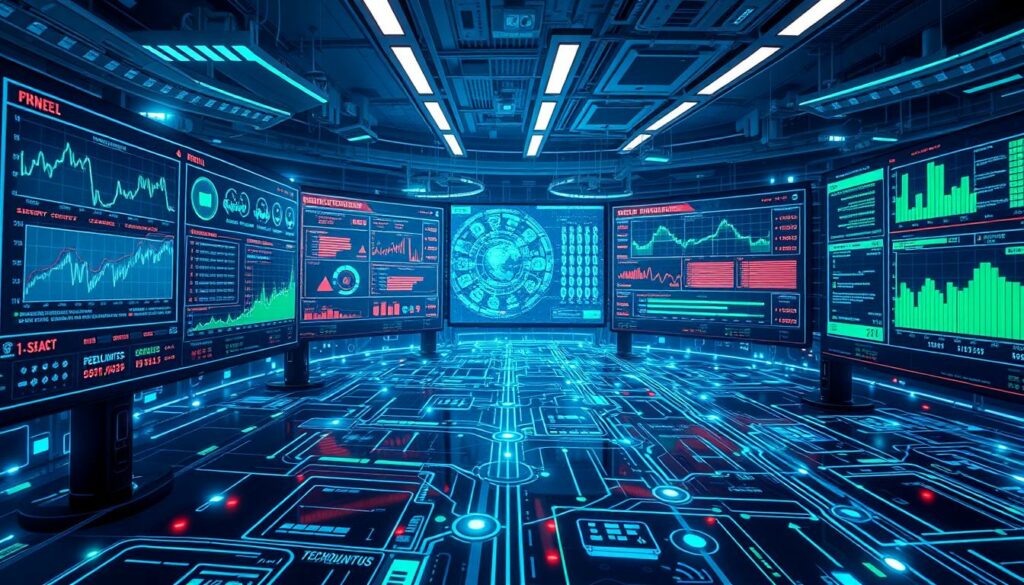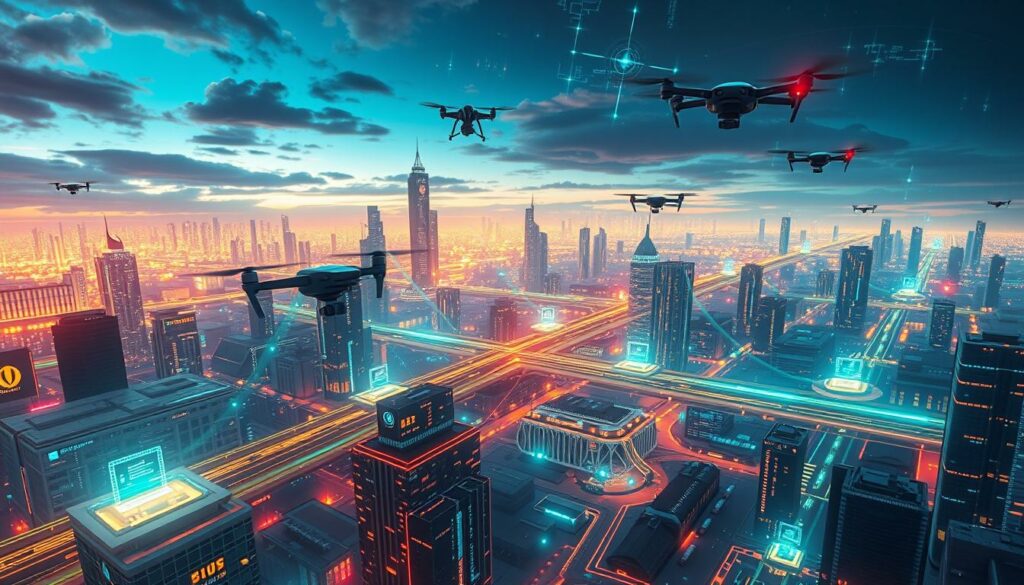Did you know the Cicada3301 ransomware operation has hit 23 victims since mid-June? Cyber threats are growing fast, making it hard for companies to keep data safe. AI in Cybersecurity is now key, changing how we protect data and work more efficiently. It helps businesses handle risks and fight off complex cyber attacks.
With more data breaches happening, using AI is vital for keeping data safe and winning back trust. AI is changing how we deal with cybersecurity, helping us stay ahead of threats.
Key Takeaways
- AI plays a critical role in modernizing cybersecurity defenses.
- Cicada3301 shows how urgent advanced cybersecurity is.
- Adding AI boosts data protection and user trust.
- AI’s quick growth offers new ways to spot threats.
- Being alert is key as ransomware gets more sophisticated.
- AI helps companies react quicker to threats.
Understanding the Role of AI in Cybersecurity
Artificial Intelligence is changing how we fight cyber threats. Machine learning and large language models (LLMs) help spot vulnerabilities and manage cybersecurity roles well. AI automates tasks, making it faster to analyze huge amounts of data.
Generative AI can find unusual patterns that might mean a cyberattack is coming. This tech helps cybersecurity teams see threats early. It lets them act fast and focus on harder problems that need a human touch.
AI in Cybersecurity automates tasks like patch management and system updates. This means IT teams have less work and fewer chances for mistakes. Machine learning makes profiles of normal user behavior. If a user acts out of the norm, it alerts the team to check for security issues.
AI is a big help in making security stronger, but it also brings new challenges. Cybercriminals use AI to make better phishing scams and attacks. Knowing about these challenges helps us use AI wisely. For more on how AI is changing cybersecurity, check out this resource.
Benefits of Integrating AI into Cybersecurity
Adding AI to cybersecurity brings many benefits that make security better. Companies see how AI helps fight modern threats. The main advantages are better threat detection and quicker response times.
Enhanced Threat Detection
AI changes how we spot threats. Old methods can’t keep up with new threats fast enough. AI looks at lots of data to find patterns and oddities that could be threats.
It gets better at spotting threats over time thanks to machine learning. This means it can find new threats early, lowering the risk of attacks. It helps protect important information.
Faster Response Times
AI makes responding to threats quicker. It automates actions against threats, acting fast to stop problems before they get worse. This quick action saves time and resources.
Companies using AI can deal with threats right away. This keeps them ahead of cybercriminals.
| Benefit | Description |
|---|---|
| Enhanced Threat Detection | Uses AI to spot patterns in data for early threat detection. |
| Faster Response Times | Automates threat handling to cut down response time. |
Challenges Faced by Traditional Cybersecurity Measures
Traditional cybersecurity methods face big challenges in today’s world. Cybercriminals are getting better at finding and using weaknesses. This makes data privacy a big worry, especially with lots of sensitive info stored in one place.
Data Privacy Concerns
Storing sensitive data in one place makes it easier for hackers to get in. If they do, many people’s privacy could be at risk. This could lead to big legal troubles and harm to a company’s reputation. Protecting personal info from hackers is now a top priority.
Vulnerability to Cyberattacks
Old-school cybersecurity can’t handle the complex attacks hackers use today. As hackers get better with technology, traditional defenses fall behind. Phishing attacks are getting more convincing, making things even riskier. It’s clear that moving to AI-driven solutions is crucial for strong defense.
| Challenge | Traditional Response | AI-Driven Solution |
|---|---|---|
| Data Privacy | Centralized data management | Decentralized data encryption |
| Cyberattack Vulnerabilities | Static security measures | Dynamic, adaptive threat detection |
| Incident Response | Reactive responses | Proactive, automated incident management |
| Insider Threats | Manual monitoring | Behavioral analysis and anomaly detection |
AI Technologies Revolutionizing Cybersecurity
AI technologies are changing how we fight cyber threats. They use machine learning algorithms and systems to spot unusual patterns. This helps protect against complex cyber attacks by quickly going through huge amounts of data.
GenAI helps automate simple security tasks. This means less work for cybersecurity teams and better system protection. When a cyber-attack happens, AI can respond fast by finding and fixing problems quickly.
GenAI also makes fake emails that can trick people, making phishing attacks worse. Deepfake technology, also powered by GenAI, can make fake videos and audio. This makes it harder to know what’s real and what’s not.
Here’s how AI is changing cybersecurity:
| Statistic | Impact |
|---|---|
| 63% increase in cyber attacks due to COVID-19 | Heightened urgency for advanced AI solutions |
| 55% of IT professionals receive over 10,000 threats daily | Challenge in managing and responding to threats effectively |
| 27% receive more than one million threats daily | Overwhelming numbers demand innovative detection systems |
| 53% struggle to identify critical security incidents | Need for proactive AI-driven alert systems |
| Recommendation to replace boards after data breaches | Highlighting the necessity of oversight in cyber risk management |
Using AI in cybersecurity means having defenses that can change with new threats. Knowing how AI works is key to tackling today’s complex cybersecurity challenges.
How AI in Cybersecurity Detects Threats
Organizations now use artificial intelligence to boost their security. AI helps with threat detection through machine learning and behavioral analysis. These methods are key in spotting and stopping security risks early.
Machine Learning Algorithms
Machine learning changes the game in cybersecurity, especially in finding threats. It lets security systems look at huge amounts of data fast. By using these algorithms, systems can spot unusual patterns that might mean a threat is coming.
This quick spotting helps organizations act fast against new risks.
Behavioral Analysis
Behavioral analysis works with machine learning to look at how users act in a network. It makes detailed profiles of normal behavior. This way, it can quickly spot actions that don’t fit the usual pattern.
These odd actions get checked, keeping security strong and cutting down on false alarms.
| Methodology | Description | Benefits |
|---|---|---|
| Machine Learning Algorithms | Analyze large data sets to recognize patterns or anomalies | Enhances threat detection speed and accuracy |
| Behavioral Analysis | Assess user behavior to identify unusual activity | Improves protection against insider threats |
Real-Time Monitoring and Incident Response
In today’s fast-changing cybersecurity world, Real-Time Monitoring is key. It lets organizations watch and check network traffic all the time. This way, they can spot unusual activities right away, which might mean a threat is coming.
Having strong monitoring systems helps improve how quickly you can react to incidents. This means you can act faster when there’s a breach.
Good cybersecurity solutions use the latest tech for Real-Time Monitoring. They use artificial intelligence and machine learning to find threats automatically. This cuts down on the work for human analysts and makes sure threats are caught and fixed fast.
Adding AI to incident response plans is crucial for strong cybersecurity. When systems quickly look at data and link incidents, the response team can act fast. This helps lessen damage and get security back quickly.

This proactive way of handling incidents makes for a safer place for important assets. Companies that focus on Real-Time Monitoring and quick incident response are ready for the increasing threats. They keep their data safe and keep their stakeholders’ trust.
AI in Cybersecurity: The New Frontier in Protecting Data
Organizations face more data threats today. Using artificial intelligence in cybersecurity is changing how we protect data. AI uses advanced algorithms to boost security, making it harder for hackers to get through. It also helps in quickly responding to security issues.
AI can look at huge amounts of data fast. This helps in stopping attacks before they start. It also helps in making strong security plans.
The Impact on Data Protection Strategies
AI has made data protection better. With AI, companies can:
- Boost threat detection with predictive analytics, catching breaches early.
- Automate security responses, making recovery from cyber threats quicker.
- Use machine learning to make defenses better over time.
- Make sure data is safe and secure with centralized and decentralized analytics.
Case Studies of Successful Implementations
Real-world examples show how AI helps in cybersecurity. Look at these cases:
| Company | AI Implementation | Cybersecurity Success |
|---|---|---|
| Company A | Real-time threat detection system using machine learning algorithms | Reduced data breaches by 40% |
| Company B | Automated incident response protocols | Decreased response time to threats by 70% |
| Company C | Behavioral analytics for user access control | Strengthened data protection by identifying unusual user activity |
The Future of AI in Cybersecurity
The cybersecurity world is changing fast, and we need new solutions. The future is looking at generative AI to help fight threats by looking at lots of data quickly. This helps spot unusual patterns that could mean an attack is coming.
AI is making it faster to respond to cyber attacks. Generative AI helps figure out what went wrong, so teams can focus on fixing it. This means less damage and quicker recovery, which is key in today’s complex cyber world.
Tasks like keeping systems up to date can take a lot of time and effort. AI helps automate these tasks, easing the load on IT teams and cutting down on mistakes. As companies use more deep learning, they get better at handling cyber risks.
But, using generative AI has its downsides. Cybercriminals can use AI to make fake emails and malware that’s hard to spot. Deepfake technology makes things even tougher, as attackers can pretend to be anyone in video calls, putting personal and business security at risk.
Experts predict big growth for the AI in Cybersecurity Market, going from USD 14.9 million in 2023 to USD 118.9 million by 2030. This shows how AI is becoming key in making cybersecurity better in fields like BFSI, healthcare, and government.
The future of cybersecurity will be shaped by new tech and the threats they face. Companies need to stay alert, using AI tools wisely while getting ready for the next big cyber challenges.

Collaborative Defense Systems Powered by AI
In today’s fast-changing cybersecurity world, companies need new ways to protect their digital assets. Collaborative Defense systems are a big step forward. They use the strengths of many groups to make security better. With AI, these systems can work together to fight off cyber threats more effectively.
Cloud Security Enhancements
Cloud computing brings both chances and challenges for cybersecurity. Using Collaborative Defense in the cloud helps companies manage their security better. AI is key here, as it automates finding and dealing with threats. By using data from many sources, AI gets better at spotting weak points.
Working together, companies can see threats more clearly. Sharing information helps spot unusual activity faster, making everyone safer. With Collaborative Defense, everyone stays alert and works together to tackle Cloud Security issues.
More companies are seeing the value of teamwork in fighting cyber threats. Sharing knowledge and resources among businesses makes defenses stronger. It also helps them bounce back from attacks. Learn more about how Collaborative Defense can change your cybersecurity.
The Importance of Ongoing AI Training and Adaptation
In the fast-changing world of cybersecurity, the role of ongoing AI training is crucial. It’s key for AI systems to keep up with new threats. By learning continuously, these systems can improve their threat detection, keeping organizations safe.
Regular updates are a must for keeping AI technologies effective. As threats change, so must the defenses against them. A strong AI training plan boosts threat detection accuracy, leading to quicker responses. This cycle of improvement helps in being proactive in cybersecurity.
AI systems need to keep learning because cyberattacks are getting more complex. With new attack methods, your tools must be ready to spot and stop threats. This shows the importance of balancing AI training with cybersecurity adaptation.
To get the most from your cybersecurity efforts, focus on ongoing AI training. This ensures your systems are ready for current threats and future ones too.
Conclusion
AI is becoming key in Cybersecurity today. Cyber attacks jumped by 63 percent during the COVID-19 pandemic. This shows how important strong data protection is now.
Organizations using AI in their Cybersecurity get better at spotting threats. They also prepare for the complex attacks hackers use.
The future of Cybersecurity relies on using AI solutions. With over 10,000 threats found daily, it’s crucial for SOC teams to have the right tools. These tools help them focus on the most important risks.
By using AI, you can make your organization more open and responsible. This leads to better data protection.
Adding AI to CyberSecurity is a must for companies wanting a strong defense against new threats. It helps make users feel safe, which boosts your company’s image. Investing in AI means investing in your security and how well your operations run.
FAQ
What is the role of AI in cybersecurity?
AI is key in cybersecurity. It helps find threats, automate responses, and give security experts useful insights. It looks through lots of data to spot unusual patterns and weaknesses.
How does AI improve data protection strategies?
AI makes data protection better by watching in real-time. It lets companies act fast when something goes wrong. By always checking network traffic and how users behave, AI spots threats early, reducing risks.
What are the benefits of incorporating AI into cybersecurity systems?
Adding AI to cybersecurity systems boosts threat detection and quickens response times. It also spots new threats fast by learning from past attacks. This cuts down damage and downtime from cyber attacks.
What challenges do traditional cybersecurity measures face?
Old cybersecurity methods struggle with new cyber threats and data privacy worries, especially with storing data in one place. This shows why we need AI solutions that can change and grow with new threats.
What AI technologies are revolutionizing cybersecurity?
AI is changing cybersecurity with machine learning, anomaly detection, and behavioral analysis tools. These tools make security systems stronger and more adaptable to fight complex attacks.
How does AI detect security threats?
AI finds threats with machine learning algorithms and tools that check for unusual user behavior. This helps companies spot and stop potential breaches early.
Why is real-time monitoring essential in cybersecurity?
Real-time monitoring is key because it lets companies act fast when something goes wrong. AI keeps an eye out for strange activity, helping stop threats before they can do harm, protecting data.
What future trends can we expect from AI in cybersecurity?
The future of AI in cybersecurity looks bright with new tools that can predict and stop risks before they happen. New technologies will change how companies plan their cybersecurity strategies worldwide.
How can organizations benefit from collaborative defense systems using AI?
With AI-powered collaborative defense systems, companies get better communication and coordinated responses from different security tools. This makes cloud security and overall cybersecurity better.
Why is ongoing training important for AI systems in cybersecurity?
Keeping AI systems in cybersecurity trained is key because it lets them keep learning and adapting to new threats. Regular updates and improvements keep AI effective in finding and handling security issues.
Source Links
- A new variant of Cicada ransomware targets VMware ESXi systems
- China is beating the world at scientific research, ASPI finds | Why ‘paranoid’ Russia’s ties with China should worry Australia | Silicon Valley’s hot talent pipeline is an Israeli army unit
- GenAI in Cybersecurity: A Double-Edged Sword for Defence and Offense
- Evaluating Environmental Sustainability: The Role of Agriculture and Renewable Energy in South Korea
- Only 26% of Organizations Have Implemented Generative AI Standards: Navigating Enterprise AI Governance
- Passkey Adoption Is Accelerating in APAC — Except for Australia
- Optimized Intrusion Detection for IoMT Networks with Tree-Based Machine Learning and Filter-Based Feature Selection
- Microsoft vulnerability that could enable data theft is now patched
- Survey: How Do Elite Chinese Students Feel About the Risks of AI? — EA Forum
- A Practical Guide to Risk-Based Cybersecurity Reporting.pdf
- PEAKLIGHT Dropper: Hackers Target Windows With Downloads
- Oil and Gas Security and Service Market to Reach USD 43.74 Billion by 2032 Due to Rising Cybersecurity Threats and Physical Security Concerns | Research by SNS Insider
- CrowdStrike Lowers Guidance Due to Outage Impact. Is The Worst Over for the Stock? | The Motley Fool
- Unlocking the Power of Data: Blockchain-Based Analytics in Video Streaming Services
- Desperately seeking simulation
- The Ultimate Guide to Claiming and Tracking Dymension Airdrops Securely
- Artificial Intelligence (Ai) In Cybersecurity Market Likely To Boost Future Growth | FireEye, Thales Group
- The Double-Edged Sword in Cyber Warfare
- Bumper and Keyloop launch digital payment solutions for automotive dealers
- ESC 2024: GLP-1RAs lower CV risk in meta-analysis of 32,883
- Validity and Reliability of Movesense HR+ ECG Measurements for High-Intensity Running and Cycling
- Influence of Tea Polyphenols, Chitosan, and Melatonin as the Eco-Friendly Post-Harvest Treatments on the Vase Life of the Cut Chrysanthemum ‘Pingpong’ Group
- Artificial Intelligence in Net-Zero Carbon Emissions for Sustainable Building Projects: A Systematic Literature and Science Mapping Review
- Ketryx tackles software safety in medical devices amid growing recalls
- I Learned About AI Mistakes That Could Change Your Life
- Sustainable & Green Energy Solutions for Next‑Gen Data Centers Trend Report
- Learn How to Start a Career in a Data Centre: Skills, Certifications & First Steps
- My Guide to Understanding Data Centre Architecture: Core Components Every IT Pro Should Know
- Wazuh Home Network Setup: A Step-by-Step Guide




